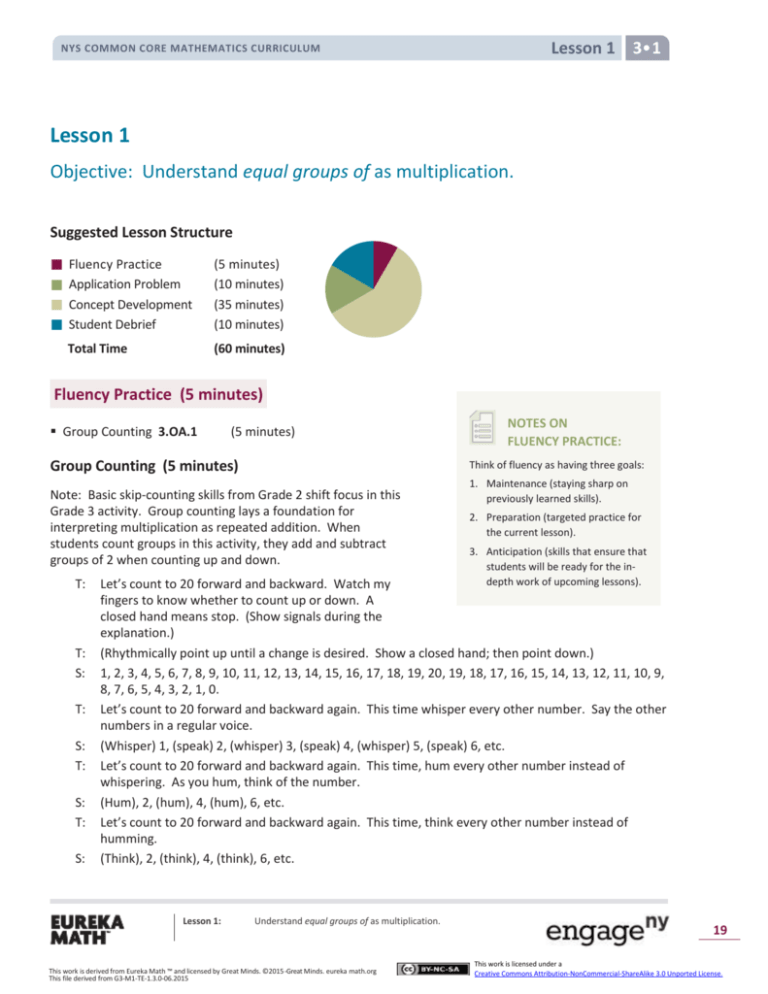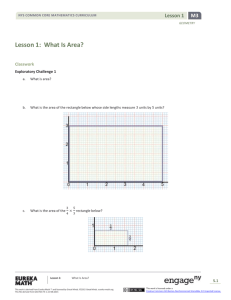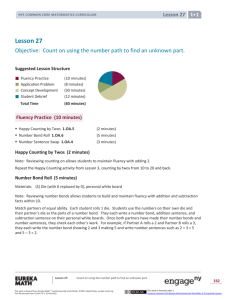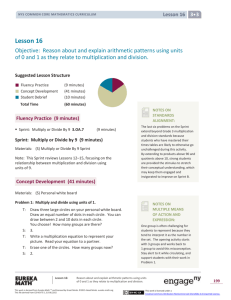Lesson 1 - EngageNY
advertisement

Lesson 1 3•1 NYS COMMON CORE MATHEMATICS CURRICULUM Lesson 1 Objective: Understand equal groups of as multiplication. Suggested Lesson Structure Fluency Practice Application Problem Concept Development Student Debrief Total Time (5 minutes) (10 minutes) (35 minutes) (10 minutes) (60 minutes) Fluency Practice (5 minutes) Group Counting 3.OA.1 (5 minutes) Group Counting (5 minutes) Think of fluency as having three goals: Note: Basic skip-counting skills from Grade 2 shift focus in this Grade 3 activity. Group counting lays a foundation for interpreting multiplication as repeated addition. When students count groups in this activity, they add and subtract groups of 2 when counting up and down. T: T: S: T: S: T: S: T: S: NOTES ON FLUENCY PRACTICE: 1. Maintenance (staying sharp on previously learned skills). 2. Preparation (targeted practice for the current lesson). 3. Anticipation (skills that ensure that students will be ready for the indepth work of upcoming lessons). Let’s count to 20 forward and backward. Watch my fingers to know whether to count up or down. A closed hand means stop. (Show signals during the explanation.) (Rhythmically point up until a change is desired. Show a closed hand; then point down.) 1, 2, 3, 4, 5, 6, 7, 8, 9, 10, 11, 12, 13, 14, 15, 16, 17, 18, 19, 20, 19, 18, 17, 16, 15, 14, 13, 12, 11, 10, 9, 8, 7, 6, 5, 4, 3, 2, 1, 0. Let’s count to 20 forward and backward again. This time whisper every other number. Say the other numbers in a regular voice. (Whisper) 1, (speak) 2, (whisper) 3, (speak) 4, (whisper) 5, (speak) 6, etc. Let’s count to 20 forward and backward again. This time, hum every other number instead of whispering. As you hum, think of the number. (Hum), 2, (hum), 4, (hum), 6, etc. Let’s count to 20 forward and backward again. This time, think every other number instead of humming. (Think), 2, (think), 4, (think), 6, etc. Lesson 1: Understand equal groups of as multiplication. This work is derived from Eureka Math ™ and licensed by Great Minds. ©2015 -Great Minds. eureka math.org This file derived from G3-M1-TE-1.3.0-06.2015 19 This work is licensed under a Creative Commons Attribution-NonCommercial-ShareAlike 3.0 Unported License. NYS COMMON CORE MATHEMATICS CURRICULUM T: S: T: Lesson 1 3•1 What did we just count by? Turn and talk to your partner. Twos. Let’s count by twos. (Direct students to count forward to and backward from 20, changing directions at times.) Application Problem (10 minutes) There are 83 girls and 76 boys in the third grade. How many total students are in the third grade? Note: Students may choose to use a tape diagram or a number bond to model the problem. They are also likely to solve today’s Application Problem in less than 10 minutes. Ten minutes have been allotted to allow for review of the RDW (Read, Draw, Write) process for problem solving. Directions on the Read, Draw, Write (RDW) process: Read the problem, draw and label, write an equation, and write a word sentence. The more students participate in reasoning through problems with a systematic approach, the more they internalize those behaviors and thought processes. (Excerpted from “How to Implement A Story of Units.” A more complete explanation can also be found in the Grade 3 Module 1 Overview.) Concept Development (35 minutes) Materials: (S) 12 counters, personal white board Problem 1: Skip-count to find the total number of objects. T: S: T: S: (Select 10 students to come to the front.) At the signal, say how many arms you each have. (Signal.) 2 arms! Since we each represent a group of 2 arms, let’s skip-count our volunteers by twos to find how many arms they have altogether. To keep track of our count, students will raise up their arms when we count them. (Count 2, 4, 6, … 20.) Lesson 1: Understand equal groups of as multiplication. This work is derived from Eureka Math ™ and licensed by Great Minds. ©2015 -Great Minds. eureka math.org This file derived from G3-M1-TE-1.3.0-06.2015 20 This work is licensed under a Creative Commons Attribution-NonCommercial-ShareAlike 3.0 Unported License. NYS COMMON CORE MATHEMATICS CURRICULUM T: S: T: S: T: S: T: S: T: T: S: T: S: T: Lesson 1 3•1 How many raised arms do we have in all? 20. Arms down. How many twos did we count to find the total? Turn and whisper to your partner. 10 twos. What did you count to find the number of twos? I counted the number of volunteers because each person has a group of two arms. Sample Teacher Board Skip-count to find the total number of arms. (Say 2, 4, 6, …) (As they count, write 2 + 2 + 2 +…) Look at our addition sentence. Show thumbs up if you see the correct number of twos. (Show thumbs up.) (Under the addition sentence, write 10 twos.) Clap 3 times if you agree that 10 groups of two is 20. (Clap 3 times.) (Write 10 groups of two is 20 under the other number sentences.) Problem 2: Understand the relationship between repeated addition, counting groups in unit form, and multiplication sentences. Seat students at tables with personal white boards and 12 counters each. T: S: T: S: T: S: T: S: T: S: T: S: T: You have 12 counters. Use your counters to make equal groups of two. How many counters will you put in each group? Show with your fingers. (Hold up 2 fingers and make groups of two.) How many equal groups of two did you make? Tell at the signal. (Signal.) 6 groups. 6 equal groups of how many counters? 6 equal groups of 2 counters. 6 equal groups of 2 counters equal how many counters altogether? 12 counters. Sample Teacher Board Write an addition sentence to show your groups on your personal white board. (Write 2 + 2 + 2 + 2 + 2 + 2 = 12.) (Record the addition sentence on the board.) In unit form, how many twos did we add to make 12? 6 twos. (Record 6 twos = 12 under the addition sentence.) 6 × 2 is another way to write 2 + 2 + 2 + 2 + 2 + 2 or 6 twos. (Record 6 × 2 = 12 under 6 twos = 12 on the board.) These number sentences are all saying the same thing. Lesson 1: Understand equal groups of as multiplication. This work is derived from Eureka Math ™ and licensed by Great Minds. ©2015 -Great Minds. eureka math.org This file derived from G3-M1-TE-1.3.0-06.2015 21 This work is licensed under a Creative Commons Attribution-NonCommercial-ShareAlike 3.0 Unported License. Lesson 1 3•1 NYS COMMON CORE MATHEMATICS CURRICULUM T: S: Turn and talk to your partner. How do you think 6 × 2 = 12 relates to the other number sentences? They all have twos in them, and the answer is 12. I think the 6 shows how many twos there are. You NOTES ON have to count two 6 times because there are 6 groups MULTIPLE MEANS of them. That’s how you get 6 times 2. 6 × 2 might OF REPRESENTATION: be an easier way to write a long addition sentence. T: Ways that are easier and faster are efficient. When we have equal groups, multiplication is a more efficient way to find the total than repeated addition. Repeat the process with 4 threes, 3 fours, and 2 sixes to get students comfortable with the relationship between repeated addition, counting groups in unit form, and multiplication sentences. It may be necessary to explicitly connect times and the symbol ×. Have students analyze the model. “How many times do you see a group of two?” Have them count the groups, write the number sentence, and say the words together. 6 groups of two equal 12. 6 times 2 equals 12. Problem 3: Write multiplication sentences from equal groups. Draw or project the picture to the right. T: S: T: S: T: These are equal groups. Turn and tell your partner why they are equal. There is the same number of grey circles in each group. All of the grey circles are the same size and shape, and there are 4 in each group. Work with your partner to write a repeated addition and a multiplication sentence for this picture. (Write 4 + 4 = 8 and either 2 × 4 = 8 or 4 × 2 = 8.) (Project or draw the following.) Look at my new drawing and the multiplication sentence I wrote to represent it. Check my work by writing an addition sentence and counting to find the total number of objects. 3 × 4 = 12 MP.3 S: T: S: T: NOTES ON MULTIPLE MEANS OF ACTION AND EXPRESSION: Some students may need more scaffolding to realize that multiplication cannot be used to find totals with groups that are not equal. Use the following questions to scaffold. Does the drawing show 3 fours? Does 3 times 4 represent this drawing? How might we redraw the picture to make it show 3 × 4? (Write 4 + 4 + 3 = 11.) Use your addition sentence as you talk to your partner about why you agree or disagree with my work. I disagree because my addition sentence equals 11, not 12. It’s because that last group doesn’t have 4 circles. You can do multiplication when the groups are equal. Here, the groups aren’t equal, so the drawing doesn’t show 3 × 4. I hear most students disagreeing because my groups are not equal. True, to multiply you must have equal groups. Lesson 1: Understand equal groups of as multiplication. This work is derived from Eureka Math ™ and licensed by Great Minds. ©2015 -Great Minds. eureka math.org This file derived from G3-M1-TE-1.3.0-06.2015 22 This work is licensed under a Creative Commons Attribution-NonCommercial-ShareAlike 3.0 Unported License. NYS COMMON CORE MATHEMATICS CURRICULUM Lesson 1 3•1 Problem Set (10 minutes) Students should do their personal best to complete the Problem Set within the allotted 10 minutes. Some problems do not specify a method for solving. This is an intentional reduction of scaffolding that invokes MP.5, Use Appropriate Tools Strategically. Students should solve these problems using the RDW approach used for Application Problems. For some classes, it may be appropriate to modify the assignment by specifying which problems students should work on first. With this option, let the purposeful sequencing of the Problem Set guide the selections so that problems continue to be scaffolded. Balance word problems with other problem types to ensure a range of practice. Consider assigning incomplete problems for homework or at another time during the day. Student Debrief (10 minutes) Lesson Objective: Understand equal groups of as multiplication. The Student Debrief is intended to invite reflection and active processing of the total lesson experience. Invite students to review their solutions for the Problem Set. They should check work by comparing answers with a partner before going over answers as a class. Look for misconceptions or misunderstandings that can be addressed in the Debrief. Guide students in a conversation to debrief the Problem Set and process the lesson. Any combination of the questions below may be used to lead the discussion. On the first page, what did you notice about the answers to your problems? Discuss the relationship between repeated addition and the unit form 2 groups of three or 3 groups of two, depending on the drawing. Discuss the relationship between repeated addition, unit form, and the multiplication sentence 3 × 2 = 6. Review the new vocabulary presented in the lesson: equal groups, multiplication, and multiply. Lesson 1: Understand equal groups of as multiplication. This work is derived from Eureka Math ™ and licensed by Great Minds. ©2015 -Great Minds. eureka math.org This file derived from G3-M1-TE-1.3.0-06.2015 23 This work is licensed under a Creative Commons Attribution-NonCommercial-ShareAlike 3.0 Unported License. NYS COMMON CORE MATHEMATICS CURRICULUM Lesson 1 3•1 Exit Ticket (3 minutes) After the Student Debrief, instruct students to complete the Exit Ticket. A review of their work will help with assessing students’ understanding of the concepts that were presented in today’s lesson and planning more effectively for future lessons. The questions may be read aloud to the students. Lesson 1: Understand equal groups of as multiplication. This work is derived from Eureka Math ™ and licensed by Great Minds. ©2015 -Great Minds. eureka math.org This file derived from G3-M1-TE-1.3.0-06.2015 24 This work is licensed under a Creative Commons Attribution-NonCommercial-ShareAlike 3.0 Unported License. Lesson 1 Problem Set 3•1 NYS COMMON CORE MATHEMATICS CURRICULUM Name Date 1. Fill in the blanks to make true statements. b. 3 + 3 + 3 + 3 + 3 = _________ a. 3 groups of five = _________ 3 fives = _________ 5 groups of three = _________ 3 × 5 = _________ 5 × 3 = _________ c. 6 + 6 + 6 + 6 = ___________ _______ groups of six = __________ 4 × ______ = __________ d. 4 +____ + ____ + ____ + ____ + ____ = _________ 6 groups of ________ = ___________ 6 × ______ = __________ Lesson 1: Understand equal groups of as multiplication. This work is derived from Eureka Math ™ and licensed by Great Minds. ©2015 -Great Minds. eureka math.org This file derived from G3-M1-TE-1.3.0-06.2015 25 This work is licensed under a Creative Commons Attribution-NonCommercial-ShareAlike 3.0 Unported License. NYS COMMON CORE MATHEMATICS CURRICULUM Lesson 1 Problem Set 3•1 2. The picture below shows 2 groups of apples. Does the picture show 2 × 3? Explain why or why not. 3. Draw a picture to show 2 × 3 = 6. 4. Caroline, Brian, and Marta share a box of chocolates. They each get the same amount. Circle the chocolates below to show 3 groups of 4. Then, write a repeated addition sentence and a multiplication sentence to represent the picture. Lesson 1: Understand equal groups of as multiplication. This work is derived from Eureka Math ™ and licensed by Great Minds. ©2015 -Great Minds. eureka math.org This file derived from G3-M1-TE-1.3.0-06.2015 26 This work is licensed under a Creative Commons Attribution-NonCommercial-ShareAlike 3.0 Unported License. Lesson 1 Exit Ticket 3•1 NYS COMMON CORE MATHEMATICS CURRICULUM Name Date 1. The picture below shows 4 groups of 2 slices of watermelon. Fill in the blanks to make true repeated addition and multiplication sentences that represent the picture. 2 + ____ + ____ + ____ = ___________ 4 × ______ = __________ 2. Draw a picture to show 3 + 3 + 3 = 9. Then, write a multiplication sentence to represent the picture. Lesson 1: Understand equal groups of as multiplication. This work is derived from Eureka Math ™ and licensed by Great Minds. ©2015 -Great Minds. eureka math.org This file derived from G3-M1-TE-1.3.0-06.2015 27 This work is licensed under a Creative Commons Attribution-NonCommercial-ShareAlike 3.0 Unported License. Lesson 1 Homework 3•1 NYS COMMON CORE MATHEMATICS CURRICULUM Name Date 1. Fill in the blanks to make true statements. a. 4 groups of five = _________ b. 5 groups of four = _________ 4 fives = _________ 5 fours = _________ 4 × 5 = _________ 5 × 4 = _________ c. 6 + 6 + 6 = ___________ d. 3 + ____ + ____ + ____ + ____ + ____ = ______ _______ groups of six = __________ 6 groups of ________ = ___________ 3 × ______ = __________ 6 × ______ = __________ Lesson 1: Understand equal groups of as multiplication. This work is derived from Eureka Math ™ and licensed by Great Minds. ©2015 -Great Minds. eureka math.org This file derived from G3-M1-TE-1.3.0-06.2015 28 This work is licensed under a Creative Commons Attribution-NonCommercial-ShareAlike 3.0 Unported License. NYS COMMON CORE MATHEMATICS CURRICULUM Lesson 1 Homework 3•1 2. The picture below shows 3 groups of hot dogs. Does the picture show 3 × 3? Explain why or why not. 3. Draw a picture to show 4 × 2 = 8. 4. Circle the pencils below to show 3 groups of 6. Write a repeated addition and a multiplication sentence to represent the picture. Lesson 1: Understand equal groups of as multiplication. This work is derived from Eureka Math ™ and licensed by Great Minds. ©2015 -Great Minds. eureka math.org This file derived from G3-M1-TE-1.3.0-06.2015 29 This work is licensed under a Creative Commons Attribution-NonCommercial-ShareAlike 3.0 Unported License.








